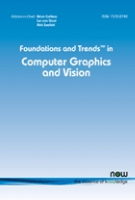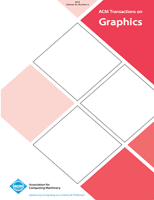
Computational Visual Media
metrics 2024
Unlocking the potential of visual media through technology.
Introduction
Computational Visual Media, published by TSINGHUA UNIVERSITY PRESS, is a premier open access journal dedicated to advancing the fields of Artificial Intelligence, Computer Graphics and Computer-Aided Design, and Computer Vision and Pattern Recognition. Since its inception in 2015, it has established a robust position within the academic community, consistently achieving Q1 rankings across its categories as of 2023. With exceptional Scopus rankings, including a remarkable percentile standing in the top 10% globally, the journal serves as a vital resource for researchers, professionals, and students eager to explore cutting-edge methodologies and technologies in computational visual media. The journal’s open access format enhances accessibility, fostering global collaboration and dissemination of knowledge, making it an indispensable platform for those at the forefront of innovation in these dynamic fields. The journal is headquartered in Beijing, China, and aims to publish high-quality research that not only contributes to theoretical advancements but also addresses practical challenges within computational visual technologies.
Metrics 2024
 4.61
4.61 17.30
17.30 -
- 27
27Metrics History
Rank 2024
Scopus
IF (Web Of Science)
JCI (Web Of Science)
Quartile History
Similar Journals

INTERNATIONAL JOURNAL OF COMPUTER VISION
Pioneering Insights in Visual Intelligence.INTERNATIONAL JOURNAL OF COMPUTER VISION, published by Springer, is a premier peer-reviewed journal that stands at the forefront of the fields of Computer Vision and Artificial Intelligence. With a remarkable impact factor and rankings placing it in the Q1 category across key areas such as Computer Vision and Pattern Recognition, as well as Software, this journal serves as an essential resource for researchers, professionals, and students alike. Since its inception in 1987, it has aimed to advance the understanding and methodologies within the rapidly evolving landscape of computer vision technologies. Its location in the Netherlands underlines its international significance, and with Scopus rankings placing it in the top percentiles of its categories, the journal is recognized for its contribution to groundbreaking research and innovative applications. Although it is not an open-access journal, it still provides extensive access options through institutional and personal subscriptions, offering its readers in-depth insights and findings pivotal to their work in artificial intelligence and computational technologies.

Visual Informatics
Bridging Creativity and ComputationVisual Informatics is a premier academic journal published by Elsevier, dedicated to advancing the fields of computer graphics, computer-aided design, and human-computer interaction. Since its launch in 2017, this Open Access journal has swiftly established itself as a leading platform for innovative research, reflected in its impressive impact factor and robust rankings in various Scopus categories. In 2023, it proudly holds positions in the top quartile (Q1) for Computer Graphics and Computer-Aided Design, Human-Computer Interaction, and Software, showcasing its influential contributions to these dynamic fields. Based in Amsterdam, Netherlands, Visual Informatics encourages the dissemination of high-quality, peer-reviewed articles that explore the intersection of visual technology and user experience, serving as an invaluable resource for researchers, professionals, and students seeking to stay at the forefront of these evolving disciplines.

JOURNAL OF VISUALIZATION
Empowering research with innovative visual techniques.JOURNAL OF VISUALIZATION, published by Springer, is a pioneering platform dedicated to advancing the fields of condensed matter physics, electrical and electronic engineering, and computer graphics through innovative visualization techniques. With an ISSN of 1343-8875 and an E-ISSN of 1875-8975, this esteemed journal has been an essential resource since its inception in 1998, and continues to shape the landscape of visualization research, boasting a Q2 ranking in key academic categories as of 2023. The journal's commitment to high-quality research is reflected in its Scopus rankings, where it stands at #47 in Computer Graphics and Computer-Aided Design, #388 in Electrical Engineering, and #222 in Condensed Matter Physics. While the journal subscribes to a traditional access model, it remains a critical outlet for researchers and professionals seeking to disseminate their findings amidst evolving technological and scientific paradigms. Situated in Germany, the JOURNAL OF VISUALIZATION encompasses a diverse array of articles that not only highlight theoretical advances but also practical applications, making it a vital resource for anyone engaged in the confluence of visual analytics and technology.

Foundations and Trends in Computer Graphics and Vision
Navigating the Future of Graphics and VisionFoundations and Trends in Computer Graphics and Vision, published by NOW PUBLISHERS INC, is a premier journal dedicated to advancing the fields of computer graphics and vision. With an impressive impact factor and ranked Q1 in the Computer Vision and Pattern Recognition category, this journal has established itself as a vital resource for cutting-edge research and trends. Spanning from 2005 to 2024, it covers a wide array of topics within its scope, featuring comprehensive reviews and insights that are essential for professionals, researchers, and students alike. The journal’s high Scopus rank, placing it in the top 4 of 106 in its discipline, underscores its relevance and authority in the field. While currently not offering open access, the importance of its curated content makes it a valuable addition to any academic library and a must-read for those looking to stay at the forefront of computer graphics and vision advancements.

IMAGING SCIENCE JOURNAL
Transforming Perspectives in Pattern RecognitionImaging Science Journal, published by Taylor & Francis Ltd, serves as a vital resource for researchers and professionals in the fields of computer vision, pattern recognition, and media technology. With an ISSN of 1368-2199 and an E-ISSN of 1743-131X, this journal has been fostering scholarly dialogue since its inception in 1997, with a converged content offering extending through 2024. Its categorization in Quartile 4 in Computer Vision and Pattern Recognition and Quartile 3 in Media Technology highlights its relevance and contributions to emerging trends in these domains. Although it ranks 36th in the Engineering - Media Technology category and 96th in Computer Science - Computer Vision and Pattern Recognition, its innovative research and insights continue to attract the attention of scholars dedicated to advancing knowledge at the intersection of imaging technologies. Offering versatile access options, this journal is essential for students, researchers, and professionals aiming to stay informed and engaged in the rapidly evolving landscape of imaging science.

CAAI Transactions on Intelligence Technology
Fostering Global Dialogue on Intelligence TechnologyCAAI Transactions on Intelligence Technology is a premier peer-reviewed journal published by WILEY, dedicated to advancing the fields of Artificial Intelligence, Computer Networks and Communications, Computer Vision and Pattern Recognition, Human-Computer Interaction, and Information Systems. Since its inception in 2017, this Open Access journal has rapidly ascended the ranks, achieving Q1 quartile status across multiple categories as of 2023, and is recognized for its rigorous standards and innovative research dissemination, evidenced by impressive Scopus rankings, including Rank #12 in Computer Vision and Pattern Recognition. Through its commitment to providing a platform for high-quality research, the journal invites contributions from scholars globally, fostering a collaborative environment that stimulates intellectual exchange and encourages advancements in intelligent technology. Addressed to researchers, professionals, and students alike, CAAI Transactions on Intelligence Technology serves as a vital resource for those aiming to stay at the forefront of technological innovation.

Journal of Imaging
Connecting Disciplines Through Cutting-Edge Imaging StudiesThe Journal of Imaging, published by MDPI, is an esteemed open-access journal dedicated to advancing the fields of Computer Graphics, Computer Vision, and Electrical Engineering. Since its inception in 2015, this journal has established a significant presence in the academic community, reflected by its impressive rankings in Scopus, including a Q2 quartile in multiple categories such as Computer Vision and Pattern Recognition and Radiology. With a commitment to disseminating high-quality research, the journal offers a platform for innovative studies and practical applications, making it an essential resource for researchers, professionals, and students alike. Operating from its base in Basel, Switzerland, the journal continues to promote scholarly work that pushes the boundaries of imaging technologies, while contributing to the global discourse in its respective fields. The open-access model ensures that valuable research is readily available, fostering collaboration and knowledge-sharing across disciplines.

International Journal on Document Analysis and Recognition
Leading the Charge in Automatic Document ProcessingInternational Journal on Document Analysis and Recognition (IJDAR), published by Springer Heidelberg, stands at the forefront of research and advancements in the field of document analysis, computer vision, and pattern recognition. With its ISSN 1433-2833 and E-ISSN 1433-2825, the journal is an essential resource for researchers and practitioners focusing on innovations in automatic document processing, image analysis, and artificial intelligence applications in document retrieval and recognition. Recognized as a Q1 journal in multiple relevant categories, including Computer Science Applications, Computer Vision and Pattern Recognition, and Software, IJDAR boasts impressive Scopus rankings that position it among the top-tier publications in these domains. The journal’s converged publication years from 1998 to 2024 offer a rich repository of knowledge essential for both theoretical and practical advancements, ensuring that researchers, professionals, and students can keep pace with the latest findings and methodologies. Access options may vary, but the journal continuously strives to facilitate the dissemination of high-quality research that contributes significantly to the academic discourse in document analysis and recognition.

ACM TRANSACTIONS ON GRAPHICS
Showcasing Breakthroughs in Visual DesignACM Transactions on Graphics, a premier journal published by the Association for Computing Machinery, stands at the forefront of research in the field of computer graphics and computer-aided design. With its ISSN 0730-0301 and E-ISSN 1557-7368, this highly respected publication has maintained a stellar reputation since its inception in 1982, showcasing groundbreaking work that spans the latest innovations and applications in graphics technology. Ranked within the top tier (Q1) of its category in 2023 and occupying the 5th position out of 106 in the Scopus rankings, this journal holds a significant impact factor, reflecting its critical role in advancing knowledge and fostering collaboration among researchers, professionals, and students alike. Although it does not offer open access options, the journal provides a diverse array of scholarly articles aimed at delineating theoretical advances, practical techniques, and emerging trends within the discipline, ensuring that its readership remains at the cutting edge of the evolving landscape of digital graphics.

JOURNAL OF MATHEMATICAL IMAGING AND VISION
Unveiling the Geometry of Vision through MathematicsJOURNAL OF MATHEMATICAL IMAGING AND VISION, published by Springer, stands as a significant platform for advancing the fields of applied mathematics, computer vision, and pattern recognition, among others. With an ISSN of 0924-9907 and an E-ISSN of 1573-7683, this esteemed journal is based in the Netherlands and has been contributing to the scholarly discourse since its inception in 1992, with a converged focus through 2024. It has achieved reputable standings within several quartiles, including Q2 rankings across applied mathematics, geometry and topology, and condensed matter physics, reflecting its impact and relevance. Notably, the journal ranks within the top 5% in Geometry and Topology and maintains robust standings in Statistics and Probability. The JOURNAL OF MATHEMATICAL IMAGING AND VISION is dedicated to publishing high-quality research that bridges theoretical perspectives with practical applications, making it an essential resource for researchers, professionals, and students who are exploring the cutting-edge of mathematical imaging and its interdisciplinary applications.